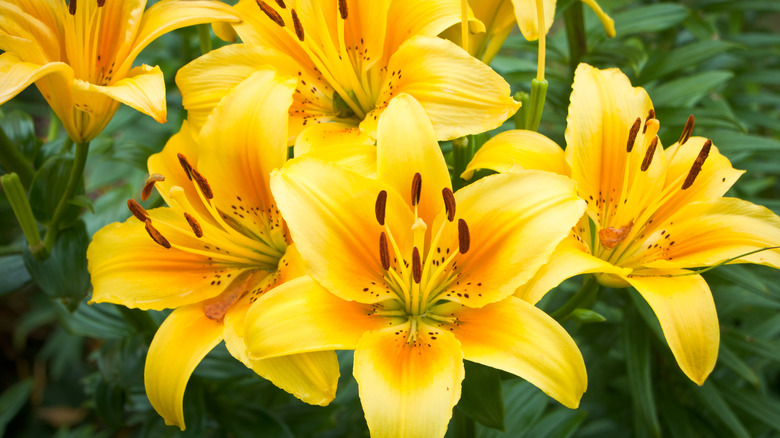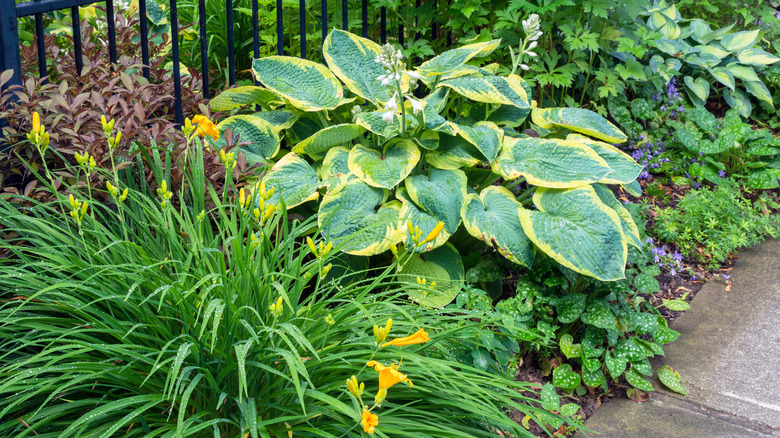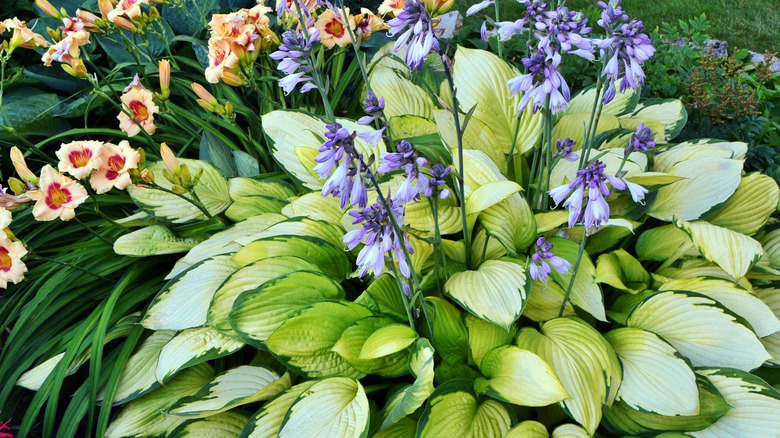Why You'll Want To Plant Daylilies With Your Hostas In The Garden
Daylilies (Hemerocallis) are some of the best flowering plants for gardens because of their beautiful, bright, and often large blooms. These robust perennials tend to be versatile for many environments and create colorful showstopping flowers. Sometimes, though, you may want to add a bit of extra foliage to all that marvelous color.
Companion planting can benefit your garden, but finding a plant that can tolerate the intensity and rapid growth of daylilies can be challenging. After all, they can grow up to 4 feet tall and spread out wide. Luckily, hostas pair beautifully with daylilies.
Hostas (Hosta plataginea) is a variety of plant species noted for their beautiful, lush foliage. Numerous varieties exist, including those that operate more like ground cover by remaining no more than 2 inches from the ground. Others can reach 4 feet tall. Hostas also contribute flowers, often of light shades like white or soft purple. These trumpet-shaped flowers are not overpowering, as most hostas are more green than bloom-heavy.
A few things help both of these plants work well together in the same garden. They both benefit from the same basic nutrients and soil conditions. Most notably, hostas are partial shade plants and can do well filling in spaces around daylilies. Daylilies also do well in partial shade, though they benefit from a bit more light. They benefit from light shade on very hot days but still need 6 hours of sunlight.
Creating the right environment for daylilies and hostas
If you're planning a new flowerbed or looking to add to an existing garden space, pairing these plants makes managing both of them easier. Both plants are rather hardy and easy to grow. Plant them side-by-side to create a stunning display.
As perennials, creating the ideal environment for daylilies and hostas could bring beautiful color and foliage for years to come. Start with the right drainage, as both plants benefit from moist soil that drains well. Since hostas can be planted in shaded areas, even under larger trees, if there's some light, make sure they get adequate watering to support growth. Daylilies need a bit more sun than that. Both plants benefit from acidic soils, too. To support this, add organic matter to the soil before planting. Adding several inches of organic matter like compost is often ideal.
Plant daylilies as much as a foot into the ground, depending on the size of the bulb or root system. The species determines how close to plant them next to each other. For hostas, create a hole that's 1.5 times the width of the rootball. You don't have to submerge the rootball fully, but make sure the hole is deep enough to cover most of it.
How to care for hostas and dayliles
Hostas don't require much maintenance and care, though you should conduct a soil test every few years and improve nutrient levels as needed. Applying a layer of organic material to them is often all they need. Mulching helps to protect moisture loss, which can be essential on hot days. Hostas are disease- and pest-resistant overall, but slugs, snails, and crown rot are issues to monitor as you care for them. Their blooms attract pollinators and provide a wonderful scent.
Daylilies are susceptible to aphid and thrip damage but are not difficult to maintain. You'll need to monitor them for proper watering. Adding fertilizer or organic matter to the soil annually will help support growth, especially for the initial blooms in the spring months. Use mulch at the base of the plant both for moisture control and to reduce the spread of weeds, which can compete for soil nutrients. Also, consider removing the daylilies once they bloom. By deadheading the flowers, you reduce the potential for the plant to produce seeds. Seed production can lead to fewer blooms the next year. It can be quite easy to care for daylilies, so sit back and enjoy the colorful flowers.


